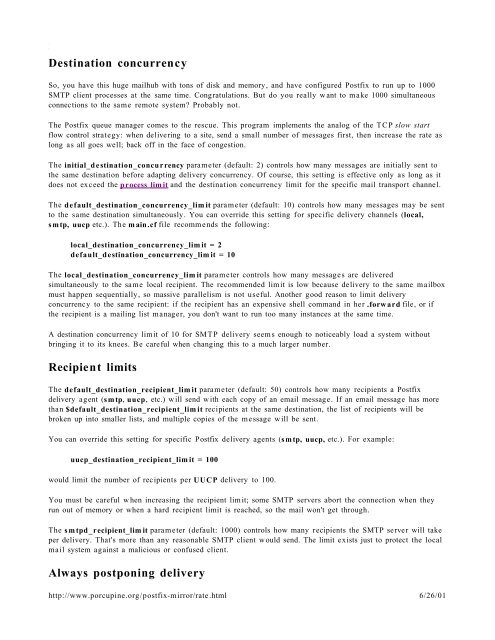Postfix Overview - Introduction - SCN Research
Postfix Overview - Introduction - SCN Research
Postfix Overview - Introduction - SCN Research
You also want an ePaper? Increase the reach of your titles
YUMPU automatically turns print PDFs into web optimized ePapers that Google loves.
<strong>Postfix</strong> Rate Controls<br />
Destination concurrency<br />
Page 2 of 4<br />
So, you have this huge mailhub with tons of disk and memory, and have configured <strong>Postfix</strong> to run up to 1000<br />
SMTP client processes at the same time. Congratulations. But do you really want to make 1000 simultaneous<br />
connections to the same remote system? Probably not.<br />
The <strong>Postfix</strong> queue manager comes to the rescue. This program implements the analog of the TCP slow start<br />
flow control strategy: when delivering to a site, send a small number of messages first, then increase the rate as<br />
long as all goes well; back off in the face of congestion.<br />
The initial_destination_concurrency parameter (default: 2) controls how many messages are initially sent to<br />
the same destination before adapting delivery concurrency. Of course, this setting is effective only as long as it<br />
does not exceed the process limit and the destination concurrency limit for the specific mail transport channel.<br />
The default_destination_concurrency_limit parameter (default: 10) controls how many messages may be sent<br />
to the same destination simultaneously. You can override this setting for specific delivery channels (local,<br />
smtp, uucp etc.). The main.cf file recommends the following:<br />
local_destination_concurrency_limit = 2<br />
default_destination_concurrency_limit = 10<br />
The local_destination_concurrency_limit parameter controls how many messages are delivered<br />
simultaneously to the same local recipient. The recommended limit is low because delivery to the same mailbox<br />
must happen sequentially, so massive parallelism is not useful. Another good reason to limit delivery<br />
concurrency to the same recipient: if the recipient has an expensive shell command in her .forward file, or if<br />
the recipient is a mailing list manager, you don't want to run too many instances at the same time.<br />
A destination concurrency limit of 10 for SMTP delivery seems enough to noticeably load a system without<br />
bringing it to its knees. Be careful when changing this to a much larger number.<br />
Recipient limits<br />
The default_destination_recipient_limit parameter (default: 50) controls how many recipients a <strong>Postfix</strong><br />
delivery agent (smtp, uucp, etc.) will send with each copy of an email message. If an email message has more<br />
than $default_destination_recipient_limit recipients at the same destination, the list of recipients will be<br />
broken up into smaller lists, and multiple copies of the message will be sent.<br />
You can override this setting for specific <strong>Postfix</strong> delivery agents (smtp, uucp, etc.). For example:<br />
uucp_destination_recipient_limit = 100<br />
would limit the number of recipients per UUCP delivery to 100.<br />
You must be careful when increasing the recipient limit; some SMTP servers abort the connection when they<br />
run out of memory or when a hard recipient limit is reached, so the mail won't get through.<br />
The smtpd_recipient_limit parameter (default: 1000) controls how many recipients the SMTP server will take<br />
per delivery. That's more than any reasonable SMTP client would send. The limit exists just to protect the local<br />
mail system against a malicious or confused client.<br />
Always postponing delivery<br />
http://www.porcupine.org/postfix-mirror/rate.html<br />
6/26/01
















